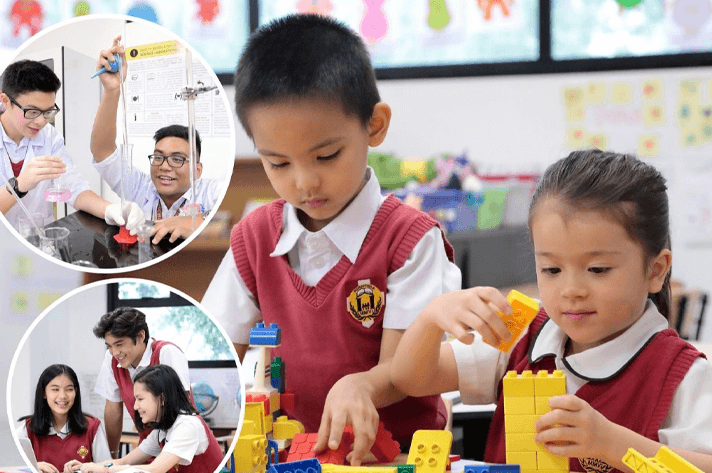
Introduction
Inculcating a love for science in kids is the best way of opening their eyes to the wondrous world of science. The sooner one does that, the better it is for the children in question.
Introducing them to easy science experiments is one of the best ways of doing that. This is something that international schools in Manila and private schools in Pasig city do.
Let us look at some easy science experiments for kids in this article.
1. Solubility Challenge
The best way to exhibit the scientific property of solubility is to ask kids to put some sugar into a glass of water and stir it with a spoon. Ask them to think about where the sugar has disappeared, thereby effectively explaining the concept of solubility to them.
2. Exploring Surface Tension With Magic Milk
This experiment involves taking a tray and covering its bottom with milk. The next thing to do is to put food colouring drops in the middle. The child is then required to dip a cotton bud in washing liquid detergent and drop it in the middle of the milk. This will make the colours move around, on account of the fact that there is immense surface tension.
This is because while food colouring would dissolve in water, milk comprises water and droplets of suspended fat which stop the food colouring from mixing very well with water. The water molecules at the surface pull each other, resulting in surface tension.
While washing liquid reduces the surface tension, it does so only where the drops fall while the remaining part of the surface pulls back resulting in the milk both churning and mixing, making one see colours.
3. Lava Lamp Experiment
Kids can be taught to perform the Lava Lamp experiment with the help of a plastic bottle, vegetable oil, water, food colouring and an Alka Seltzer tablet. The experiment involves filling up the bottle almost completely with vegetable oil and the rest of it with water.
They will find the water sinking to the bottom with the oil on top. Add a few drops of water colouring to the water which will sink to the bottom and colour the water. Next, break an Alka Seltzer tablet into several pieces and drop them into the bottle.
This will result in frenetic activity in the lava lamp. This is because the Alka Seltzer tablets react with the water and create carbon dioxide bubbles which stick to the water droplets. Since the water and gas combination is less dense than the oil, it rises to the top of the flask where it escapes into the air, thereby causing the dense water to reach the bottom all over again.
4. Dancing Raisins Are a Blast
The dancing raisins experiment is a fun science experiment that shows the ability of bubbles to raise objects, thereby changing their density. Here’s how one might perform it. One starts by putting baking soda and vinegar in water to create carbon dioxide.
This is followed by putting the raisins into the mixture. What happens is that the raisins first sink, but as bubbles attach to their surface, they will begin to rise and begin to float until the bubbles pop and the raisins will again start sinking, setting a cycle in motion that will end when the carbon dioxide gas has completely escaped. This experiment demonstrates the principle of buoyancy to children.
5. Oil and Water – Do they Mix?
Water and oil do not mix and this can be nicely displayed by a simple experiment. Pour half a glass of oil and half a glass of water into a glass and you will see them separate. As the density of oil is less than that of water, it will rise to the top.
6. Unpoppable Bubbles
Pour some water into a bowl. Next, add some food colour and mix it with the water. Now place a dish soap and stir the mixture. The next step is to put some corn syrup into the mixture. Next, take a pencil and dip its tip in it. It is now time to dip a straw into the mixture and blow air out of the other end to make bubbles. One will find that these bubbles will not pop.
Bubbles comprise a thin film of water as well as some air. By adding soap and corn syrup to water, you make the bubbles more sturdy on account of the fact that soap and corn syrup molecules can get in between the water molecules and allow the skin of the bubbles to become more stretchable.
7. Pepper and Soap
This is another fun experiment that kids will enjoy participating in. Take a plate and pour some water into it. Sprinkle some pepper into the water and see it float to the top on account of water pressure. Adding some dish soap to the water disrupts the surface tension causing the pepper to get away from the soap and move to the edges of the plate of water.
8. Dissolving Mysteries: Where Did the Salt Go?
This one is an interesting experiment about solubility. It requires one to put spoonfuls of salt into a tumbler of water and make the children participating in the experiment understand that the salt may appear to have disappeared, but has only dissolved in the water. As one keeps on putting in spoonfuls of salt, the density of the solution increases to the extent that the salt begins to collect at the bottom of the tumbler instead of disappearing like before.
9. Make a Rain Cloud in a Jar
Showing kids how to make a rain cloud in a jar will excite them to no end. Here’s what you need to do. Pour the hot water into the jar and shake it. Next, place a lid upside down and fill it with ice cubes. One needs to remove the lid, quickly spray it with hairspray and replace it. This allows the cords to form inside the jar. If you remove the lid, you can actually see the cloud escape.
Conclusion
The fun science experiments described in this article help kids develop a scientific temper at an early age, helping them develop a love of science that lasts a lifetime.

